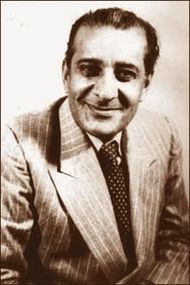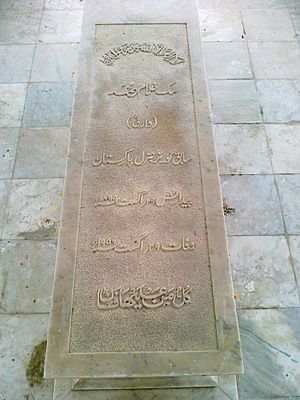Malik Ghulam Muhammad facts for kids
Quick facts for kids
Sir Malik Ghulam Muhammad
|
|
|---|---|
| ملک غلام محمد | |
 |
|
| 3rd Governor-General of Pakistan | |
| In office 17 October 1951 – 7 August 1955 |
|
| Monarch | George VI Elizabeth II |
| Prime Minister | K. Nazimuddin M. A. Bogra |
| Preceded by | Sir K. Nazimuddin |
| Succeeded by | Iskander Mirza |
| 1st Minister of Finance | |
| In office 15 August 1947 – 19 October 1951 |
|
| Prime Minister | Liaquat Ali Khan Sir K. Nazimuddin |
| Deputy | Muhammad Ali (1947–1948) Sir Victor Turner (1948–1951) |
| Preceded by | State proclaimed |
| Succeeded by | Muhammad Ali |
| Personal details | |
| Born |
Malik Ghulam Muhammad
August 29, 1895 Lahore, Punjab, British India (present-day Pakistan) |
| Died | August 29, 1956 (aged 61) Lahore, West Pakistan, Pakistan |
| Resting place | Fauji Qabrastan near CSD off Shahra-e-Faisal Karachi |
| Citizenship | |
| Political party | Independent |
| Spouse | Badshah Begum |
| Children | Two |
| Alma mater | Aligarh Muslim University (BA in Acc.) |
| Occupation | Civil servant, Chartered Accountant |
| Awards | |
Sir Malik Ghulam Muhammad (born April 20, 1895 – died August 29, 1956) was an important Pakistani politician. He served as the third Governor-General of Pakistan from 1951 to 1955. The Governor-General was like the head of state in Pakistan at that time.
He studied at Aligarh Muslim University and became a chartered accountant. This means he was an expert in managing money and accounts. Before Pakistan became independent, he worked in the Indian government's finance department.
After Pakistan gained independence in 1947, he became the country's first Finance Minister. In this role, he helped create Pakistan's first economic plans. He also helped start a company called Mahindra & Mohammed in 1945, which later became Mahindra & Mahindra.
In 1951, after the first Prime Minister, Liaquat Ali Khan, passed away, Malik Ghulam Muhammad became the Governor-General. He made some big decisions during his time in office. He had to step down in 1955 because of his health. He passed away in 1956.
Contents
Early Life and Education
Malik Ghulam Muhammad was born in Lahore, which was part of British India at the time. His family was from the Kakazai community.
He went to school in Lahore. Then, he attended the Muhammadan Anglo-Oriental College at Aligarh Muslim University (AMU). At AMU, he earned a degree in accountancy.
Career Before Independence
Working in Civil Service
After finishing university, Malik Ghulam Muhammad joined the Indian Audit and Accounts Service in 1920. This was a part of the government that managed finances. He started as an assistant audit officer for railways.
He quickly gained a reputation as a skilled accountant. He worked for various railway companies and later for the Indian Railway Board. From 1932 to 1934, he also advised the ruler of Bhopal State.
In 1934, he returned to government service. He held important financial positions in the postal and telegraph departments.
World War II and Business
During World War II, Malik Ghulam Muhammad took on even more important roles. He helped manage supplies and purchases for the government. The British government recognized his work by giving him an award called the Order of the Indian Empire in 1941.
In 1945, he helped start a steel company called Mahindra and Mohamed Steel Company. He was the company's chartered accountant. This company later became Mahindra & Mahindra, which is a very large company today.
He also advised the Nawab of Bahawalpur and started building political connections. In 1946, he joined the Ministry of Finance. He was knighted in 1946, which is why he is called "Sir."
Finance Minister (1947–1951)
In 1946, Malik Ghulam Muhammad worked as a Cabinet Secretary in the Ministry of Finance. He helped prepare India's first budget.
When Pakistan became an independent country in 1947, he chose to become a Pakistani citizen. He settled in Lahore. The first Prime Minister of Pakistan, Liaquat Ali Khan, appointed him as the country's first Finance Minister.
As Finance Minister, he presented Pakistan's first budget. He also helped create the country's first five-year economic plans. These plans aimed to improve Pakistan's economy.
In 1949, he invited leaders from Muslim countries to an economic conference in Pakistan. He wanted to promote the idea of Muslim countries working together economically. Around this time, he suffered from a serious illness that affected his ability to speak and move.
Governor-General (1951–1955)
Becoming Governor-General
In 1951, Prime Minister Liaquat Ali Khan was planning to remove Malik Ghulam Muhammad from his finance role due to his health. However, the Prime Minister was assassinated in October 1951.
After the assassination, Sir Khawaja Nazimuddin became the new Prime Minister. He resigned from his position as Governor-General and suggested that Malik Ghulam Muhammad take his place. So, on October 17, 1951, Malik Ghulam Muhammad became the Governor-General of Pakistan.
Key Decisions and Challenges
In 1953, Malik Ghulam Muhammad attended the Coronation of Elizabeth II in London. When he returned to Pakistan, there were many protests and riots happening. There was a language movement in East Pakistan (now Bangladesh) and religious riots in Lahore.
To bring back stability, he used special powers given to the Governor-General by the Government of India Act 1935. He dismissed Prime Minister Nazimuddin's government. He then appointed Mohammad Ali Bogra as the new Prime Minister.
In 1954, the Constituent Assembly tried to change the law to limit the Governor-General's powers. In response, Malik Ghulam Muhammad dismissed the Constituent Assembly. This action was very controversial. Many historians believe this event marked the beginning of a time when the military and government officials gained more power than elected leaders in Pakistan.
Health and Resignation
During this time, Malik Ghulam Muhammad's health continued to get worse. His illness, paralysis, spread throughout his body. In 1955, he had to take a leave of absence to get medical treatment in the United Kingdom.
He appointed Iskander Mirza, who was the Interior Minister, as the acting Governor-General. However, Iskander Mirza later removed Malik Ghulam Muhammad from his position and took over as Governor-General himself. This was supported by the members of the Constituent Assembly.
Death
Malik Ghulam Muhammad passed away on August 29, 1956. He was buried in Karachi, Pakistan.
See also
 In Spanish: Ghulam Muhammad para niños
In Spanish: Ghulam Muhammad para niños


